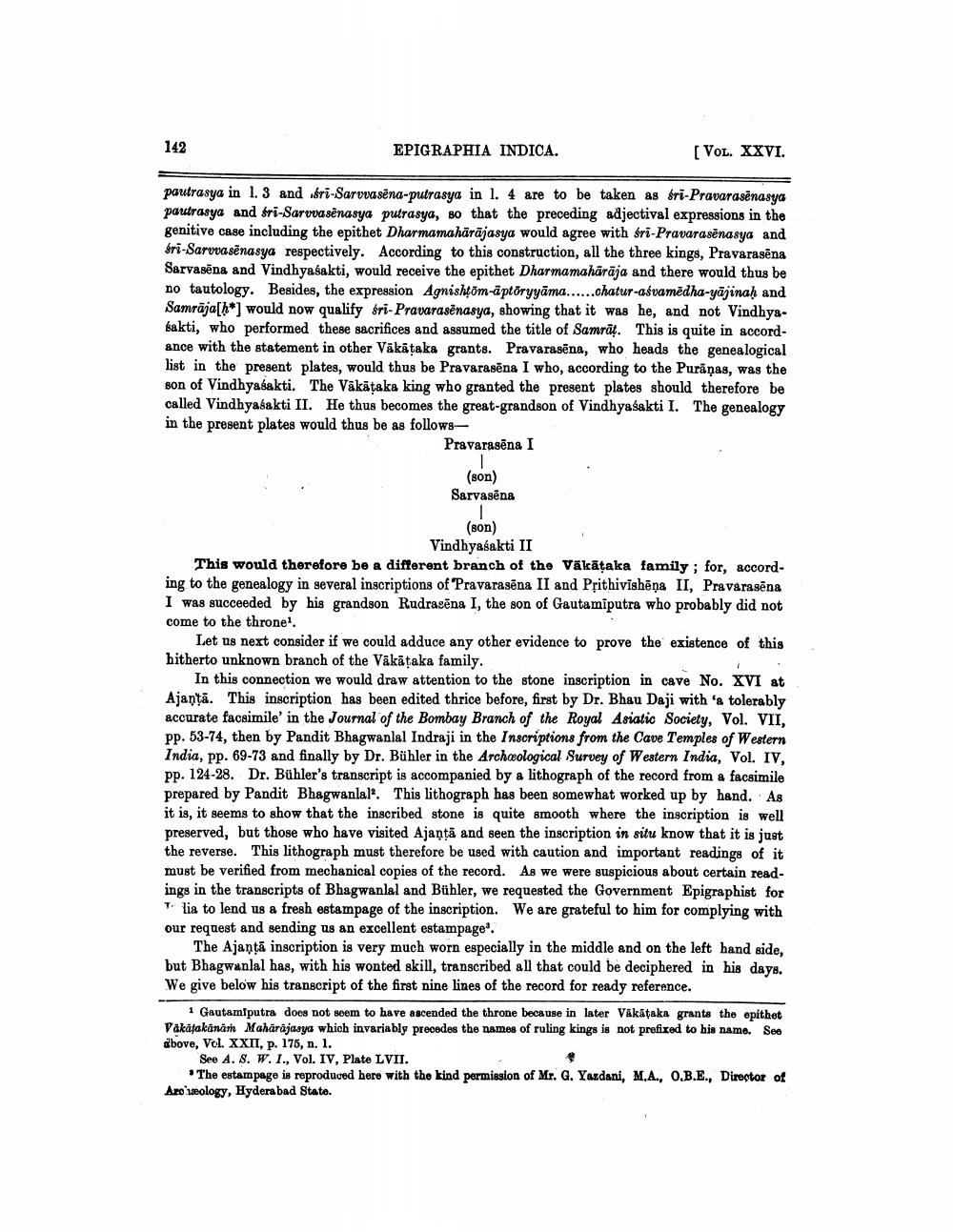________________
142
EPIGRAPHIA INDICA.
[VOL. XXVI.
pautrasya in 1. 3 and śri-Sarvvasena-putrasya in 1. 4 are to be taken as śri-Pravarasenasya pautrasya and tri-Sarvvasenasya putrasya, so that the preceding adjectival expressions in the genitive case including the epithet Dharmamahārājasya would agree with śri-Pravarasenasya and sri-Sarvvasenasya respectively. According to this construction, all the three kings, Pravarasena Sarvasena and Vindhyasakti, would receive the epithet Dharmamahārāja and there would thus be no tautology. Besides, the expression Agnishtöm-aptoryyama......chatur-aśvamedha-yajinaḥ and Samraja[*] would now qualify śri-Pravarasenasya, showing that it was he, and not Vindhyasakti, who performed these sacrifices and assumed the title of Samrat. This is quite in accordance with the statement in other Vākāṭaka grants. Pravarasēna, who heads the genealogical list in the present plates, would thus be Pravarasena I who, according to the Puranas, was the son of Vindhyasakti. The Vākāṭaka king who granted the present plates should therefore be called Vindhyasakti II. He thus becomes the great-grandson of Vindhyasakti I. The genealogy in the present plates would thus be as follows
Pravarasēna I I
(son)
Sarvasena
(son) Vindhyalakti II
This would therefore be a different branch of the Väkäṭaka family; for, according to the genealogy in several inscriptions of Pravarasena II and Prithivishēņa II, Pravarasēna I was succeeded by his grandson Rudrasena I, the son of Gautamiputra who probably did not come to the throne1.
Let us next consider if we could adduce any other evidence to prove the existence of this hitherto unknown branch of the Vākāṭaka family.
In this connection we would draw attention to the stone inscription in cave No. XVI at Ajanta. This inscription has been edited thrice before, first by Dr. Bhau Daji with 'a tolerably accurate facsimile' in the Journal of the Bombay Branch of the Royal Asiatic Society, Vol. VII, pp. 53-74, then by Pandit Bhagwanlal Indraji in the Inscriptions from the Cave Temples of Western India, pp. 69-73 and finally by Dr. Bühler in the Archaeological Survey of Western India, Vol. IV, pp. 124-28. Dr. Bühler's transcript is accompanied by a lithograph of the record from a facsimile prepared by Pandit Bhagwanlal. This lithograph has been somewhat worked up by hand. As it is, it seems to show that the inscribed stone is quite smooth where the inscription is well preserved, but those who have visited Ajanta and seen the inscription in situ know that it is just the reverse. This lithograph must therefore be used with caution and important readings of it must be verified from mechanical copies of the record. As we were suspicious about certain readings in the transcripts of Bhagwanlal and Bühler, we requested the Government Epigraphist for Tlia to lend us a fresh estampage of the inscription. We are grateful to him for complying with our request and sending us an excellent estampage3.
The Ajanta inscription is very much worn especially in the middle and on the left hand side, but Bhagwanlal has, with his wonted skill, transcribed all that could be deciphered in his days. We give below his transcript of the first nine lines of the record for ready reference.
1 Gautamiputra does not seem to have ascended the throne because in later Vākāṭaka grants the epithet Vākāṭakānāṁ Mahārājasya which invariably precedes the names of ruling kings is not prefixed to his name. See above, Vol. XXII, p. 175, n. 1.
See A. S. W. I., Vol. IV, Plate LVII.
The estampage is reproduced here with the kind permission of Mr. G. Yazdani, M.A., O.B.E., Director of Arceology, Hyderabad State.




